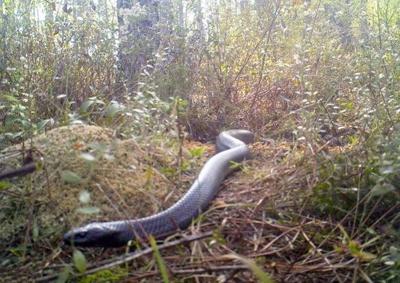TIFTON, Ga. — Two Abraham Baldwin Agricultural College students recently photographed a rare six-foot long Eastern Indigo snake while preparing capstone project research for their bachelor’s degree in Natural Resource Management at ABAC.
“This is a really noteworthy observation and of significant conservation value,” Vanessa Lane, ABAC associate professor of wildlife ecology and management and a certified wildlife biologist, said. “The sighting of this federally threatened species has already been reported to the Georgia Department of Natural Resources, and a biologist will be conducting formal surveys sometime this month.”
ABAC students Morgan Pierce from Hartwell and Scott Herkel from Norwood were using trail cameras to monitor gopher tortoise burrows on private property for their undergraduate research project. They were trying to learn what kinds of mammals and other animals were using gopher tortoise burrows when they serendipitously photographed the rare snake.
“It really was a shock,” Herkel said. “I honestly felt like it was a once in a lifetime thing.”
Lane said the Eastern Indigo snake is the largest of Georgia’s 46 snake species, reaching over eight feet long and weighing nearly 11 pounds. Famous for its ability to hunt and eat venomous snakes such as rattlesnakes, the harmless Eastern Indigo snake has unfortunately suffered steep population declines.
“The species used to range from eastern Mississippi through Florida and north to Savannah, but is now found only in isolated areas where frequently burned pine savanna habitat exists,” Lane said. “The species was listed as federally threatened under the Endangered Species Act in 1978 and has yet to fully recover. Finding an Eastern Indigo snake at a new location is heartening and means that conservation efforts are working.”
Organizations such as The Orianne Society and agencies such as the Georgia Department of Natural Resources are working with private landowners to rehabilitate pine savanna and get prescribed fire back on the landscape to help Eastern Indigo snakes and other rare wildlife.
ABAC Forest Resources faculty and students assist these organizations through public education events, volunteering with prescribed fires, and conducting undergraduate research projects to improve the public’s understanding of wildlife and their habitat.
“It was very exciting to detect a species of major conservation concern, especially since the data was collected by ABAC wildlife students,” said Matthew Carroll, ABAC assistant professor of wildlife ecology and management and mentor to the two students.
Lane realizes a snake sighting is a quite unsettling experience for many people.
“While snakes may be startling or scary to some people, it’s important to understand that all nonvenomous snake species in Georgia are protected by law,” Lane said. “If you encounter a snake you can’t identify, you can join the ‘Snake Identification’ and/or ‘What kind of snake is this? Georgia’ Facebook pages. These groups typically respond in five minutes or less.”
Snake sightings can also be reported online at www.HerpMapper.org, a database used by biologists and citizen scientists to understand reptile and amphibian distributions worldwide.
Natural Resource Management is one of 12 bachelor’s degrees offered by ABAC. Classes begin for the ABAC spring semester on Jan. 19, 2021.

























Commented
Sorry, there are no recent results for popular commented articles.